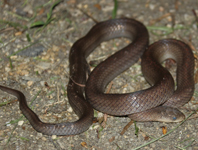Abstract
The new testate amoeba species Meisterfeldia bitsevi is described from the linden-tree trunk hollow in the urban park in Moscow (Russia). New species is characterized by elongated ovoid bilaterally symmetrical shell, which is laterally not compressed. The shell is composed of proteinaceous material without mineral particles. Almost circular subterminal aperture is placed on ventral side. The key to the species of the genus Meisterfeldia is developed.
References
Arrieira, R.L., Schwind, L.T.F., Joko, C.Y., Alves, G.M., Velho, L.F.M. & Lansac-Tôha, F.A. (2016) Relationships between environmental conditions and the morphological variability of planktonic testate amoeba in four neotropical floodplains. European Journal of Protistology, 56, 180–190.
https://doi.org/10.1016/j.ejop.2016.08.006
Balik, V. (1991) The effect of the road traffic pollution on the communities of testate amoebae (Rhizopoda, Testacea) in Warsaw (Poland). Acta Protozoologica, 30, 5–11.
Beyens, L., Chardez, D. & de Bock, P. (1986) Some new and rare testate amoebae from the Arctic. Acta Protozoologica, 25, 81–91.
Bobrov, A. (2016) Description of a new testate amoebae genus Meisterfeldia with notes on the systematics of the suborder Phryganellina (Amebozoa; Tubulinea; Arcellinida). Acta Protozoologica, 55, 211–219.
Bobrov, A. & Mazei, Yu. (2004) Morphological variability of testate amoebae (Rhizopoda: Testacealobosea: Testaceafilosea) in natural populations. Acta Protozoologica, 43, 133–146.
Bobrov, A., Yazvenko, S. & Warner, B. (1995) Taxonomic and ecological implications of shell morphology of three testaceans (Protozoa: Rhizopoda) in Russia and Canada. Archiv für Protistenkunde, 145, 119–126.
https://doi.org/10.1016/S0003-9365(11)80306-4
Mazei, Yu., Chernyshov, V., Tsyganov, A. & Payne, R. (2015) Testing the effect of refrigerated storage on testate amoeba samples. Microbial Ecology, 70, 861–864.
https://doi.org/10.1007/s00248-015-0628-1
Mitchell, E.A.D., Charman, D.J. & Warner, B.G. (2008) Testate amoebae analysis in ecological and paleoecological studies of wetlands: past, present and future. Biodiversity and Conservation, 17, 2115–2137.
https://doi.org/10.1007/s10531-007-9221-3
Payne, R., Belyakova, O. & Mazei, Yu. (2015) Community structure and environmental controls on forest epiphyte testate amoeba communities from European Russia. European Journal of Protistology, 51, 450–459.
https://doi.org/10.1016/j.ejop.2015.02.006
Tatsumi, S., Ohgue, T., Azuma, W., Tuovinen, V., Imada, Y., Mori, A.S., Thor, G. & Ranlund, A. (2017) Tree hollows can affect epiphyte species composition. Ecological Research, 32, 503–509.
https://doi.org/10.1007/s11284-017-1468-x
Wanner, M. (1999) A review on the variability of testate amoebae: methodological approaches, environmental influences and taxonomical implications. Acta Protozoologica, 38, 15–29.
Wilkinson, D.M. & Mitchell, E.A.D. (2010) Testate amoebae and nutrient cycling with particular reference to soils. Geomicrobiology Journal, 27, 520–533.
https://doi.org/10.1080/01490451003702925
Zacharias, O. (1903) Zur Kenntnis der niedern Flora und Fauna Holsteinischer Moorstumpfe. Forschungberichte aus der Biologischen Station zu Plön, 10, 223–289.


